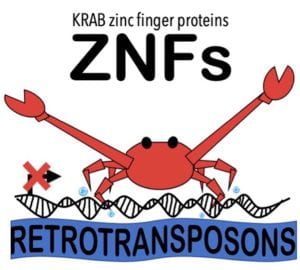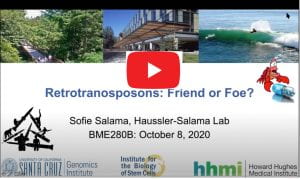Retrotransposons
Retrotransposons
Retrotransposons are the family of mobile elements that is most active in the primate lineage. Mobile elements, in general, are a major source of new DNA in genomes. In humans, almost half of our genome can be identified as the relics of

KRAB-Zinc Finger cartoon interacting with DNA
transposition events with the vast majority of these insertions resulting from retrotransposons.
Retrotransposons mobilize by first utilizing host transcription machinery to make an RNA copy of themselves, which subsequently gets reverse transcribed and inserted at a new site in the genome. Not surprisingly, a major mechanism to prevent new retrotransposition events is to inhibit retroelement (RTE) transcription. Several years ago we discovered that a large and rapidly evolving family of transcription repressor proteins, the KRAB Zinc Finger proteins (KZNFs), plays an important role in repressing RTE in early embryonic cells and that the co-evolution of RTEs and KZNFs drives increased genomic complexity.
Current projects are aimed at 1) Tracing the evolutionary history of KZNF genes in the primate lineage, taking advantage of recent high quality human and primate genome assemblies. 2) Tracing the co-evolution of specific classes of retroelements and the KZNFs that regulate them using human and great ape pluripotent stem cells. 3) Exploring the consequences of these arms races in early embryonic gene expression networks and early embryonic development.
Key Publications
An evolutionary arms race between KRAB zinc-finger genes ZNF91/93 and SVA/L1 retrotransposons
FMJ Jacobs, D Greenberg, N Nguyen, M Haeussler, AD Ewing, S Katzman, B Paten, SR Salama, David Haussler
Nature (2014) 516 (7530), 242-245
The UCSC Repeat Browser allows discovery and visualization of evolutionary conflict across repeat families
JD Fernandes, A Zamudio-Hurtado, H Clawson, WJ Kent, D Haussler, SR. Salama, M Haeussler
Funding
National Human Genome Research Institute (NHGRI), NIH

